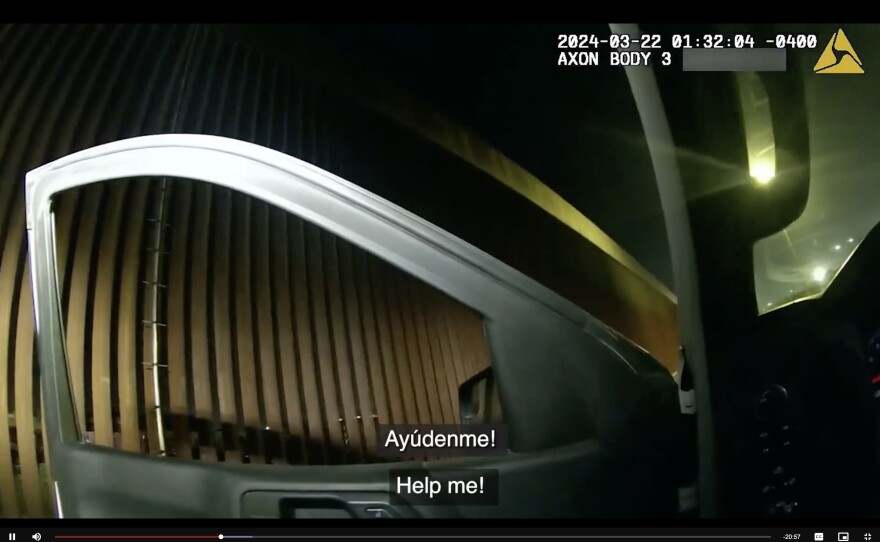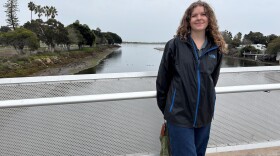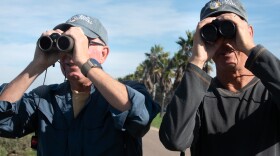Trigger Warning: This story contains content that may be distressing. It describes a video, linked to at the end of the story, that depicts a woman’s fatal fall from the U.S.-Mexico border fence, captured in body-worn camera footage.
The young woman’s pleas for help became increasingly desperate over the more than 20 minutes she was stuck on top of the U.S.-Mexico border fence in San Diego. As she screamed for help, Border Patrol agents watched from below and emergency personnel struggled to reach her.
Twice, a Border Patrol agent turned down suggestions from others to use a nearby ladder to help the woman, saying they had to wait for the fire department. Another agent led the fire engine to the wrong location, delaying their arrival.
Finally, she couldn’t hold on any longer.
“I’m gonna fall!” the woman said in Spanish, her cries audible in body-worn camera footage from a Border Patrol agent at the scene.
Then the footage captured a loud thud. The woman plummeted at least 30 feet to the ground, hitting her head on a concrete platform at the bottom of the fence before rolling onto a dirt road.
A Border Patrol agent who had driven up afterward stepped out of his vehicle to get closer.
“Oh shit, bro,” the agent said. “I think she’s done, bro.”
Petronila Elizabeth Poma Perez, a 24-year-old from Guatemala who also went by “Heidy,” was pronounced dead at the scene.
Body-worn camera footage recently released by Border Patrol sheds new light on the chaotic and confused response from agents and San Diego Fire-Rescue personnel over the 24-minute span before Poma Perez ultimately fell to her death.
It also raises questions about whether Border Patrol is doing enough to respond to emergencies along the border, which are common along the border region.
Poma Perez’s death in March is the latest among the dozens of migrants in recent years who have scaled and fallen from the border fence in their attempts to reach the U.S. between legal ports of entry. Local hospitals have seen a fivefold increase in border fall related injuries since the fence was heightened to 30 feet under former President Donald Trump in 2019.
Customs and Border Protection, Border Patrol’s overseeing agency, has faced mounting criticism from immigration advocates and aid volunteers who say agents have at times failed to respond appropriately to injured or sick migrants in need of medical care.
CBP released the video earlier this month in accordance with a 2022 presidential executive order which required federal law enforcement agencies to release body-worn camera footage in incidents resulting in serious bodily injury or a death in custody. The footage appears in an edited video that is narrated and does not provide continuous footage of the incident.
CBP did not provide comment for this story by time of publication. The agency said in March that its Office of Professional Responsibility, which investigates misconduct, was reviewing the incident.
The border is a challenging environment for emergency medical responders, but fire crews and CBP working together have saved lives over the years, according to Mónica Muñoz, spokesperson for San Diego Fire-Rescue.
“Our personnel feel horrible when a fatality occurs because our intent is always to rescue, render aid and get those folks who need further medical care to the hospital,” Muñoz said in an email.
The San Diego Police Department’s investigation found “no foul play is suspected in the death,” said Joel Tien, detective sergeant, in an email.
Lilian Serrano, director of the Southern Border Communities Coalition, an immigrant advocacy organization, said the lack of coordination displayed in the video was “shocking.”
“One, if not multiple, agents made mistakes that took somebody’s life,” Serrano said.
Serrano wants clarity on the agency’s policies.
“We want to make sure that there is an investigation that results in the agency taking real actions to prevent this type of mistake from ever being made again,” she said.
‘Stay there, do not get down’
The first agent arrived on scene at 10:30 p.m., according to CBP. He was south of the secondary fence, the northernmost of two parallel fences that make up the border barrier.
Just after the agent’s arrival, Poma Perez scaled from the south to the north side of the secondary fence when she was unable to get down. The fence, which is constructed with vertical metal bollards and has a concrete base at the bottom, is between 30 and 35 feet in this area.
“Stay there, do not get down! Please, please!” the agent yelled in Spanish. He told her an ambulance and firefighters were coming. He radioed in for help, repeating several times that the woman was stuck on the north side of the secondary fence.
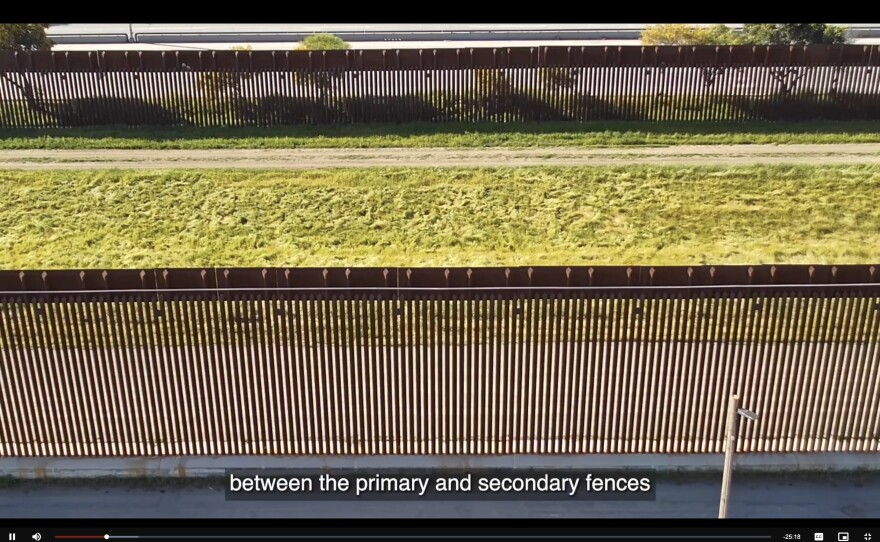
“Help me!” Poma Perez yelled.
Little is known about Poma Perez’s journey to the U.S. from Guatemala before that March 21 night, but a GoFundMe page started after her death said “all she wanted was to see her father and husband.”
She was from a small city in Guatemala called Mazatenango, according to her death certificate. inewsource was unable to reach the family for this story.
Fire-Rescue arrived to wrong location
Fire-Rescue received the call at 10:33 p.m. The dispatcher sent the nearest vehicle, a fire engine with a 24-foot ground ladder, and a Chula Vista fire truck, with a 100-foot aerial ladder.
The engine was eight minutes away and the truck was more than 15 minutes away, according to a Fire-Rescue’s dispatch records.
The realities of the border region have proven challenging for medical responders as injuries and emergencies have piled up over the years. Unmarked locations, restricted areas and unpaved roads have meant fire crews have had to rely heavily on Border Patrol to direct and allow them access to the locations of emergencies.
But that night after the engine arrived at a meeting point close to the border, a Border Patrol agent led the crew to the wrong location – to the south side of the fence, instead of the north where Poma Perez was stuck.
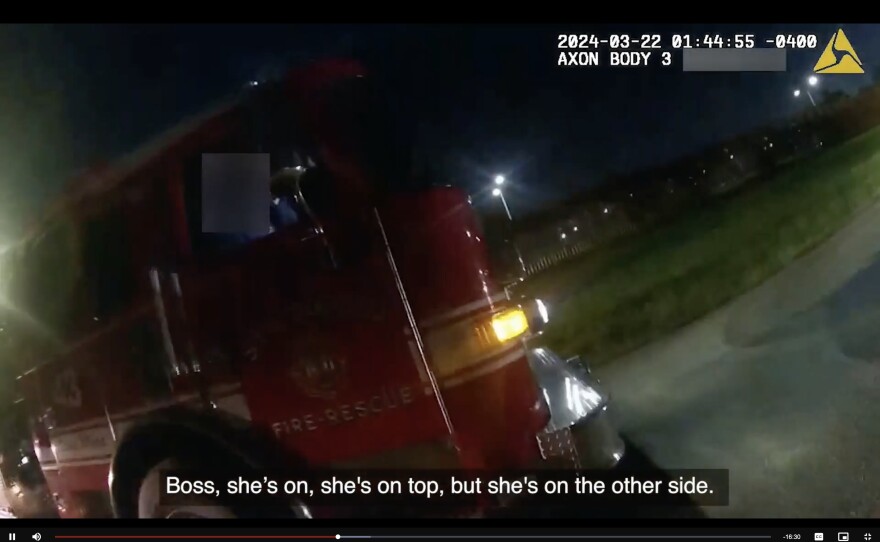
“Boss, she’s on top but on the other side,” the agent who was waiting with Poma Perez told them as they arrived.
From there, the engine crew wouldn’t be able to reach her with the 24-foot ground ladder, according to Muñoz.
Then when the agent led the engine to a nearby gate to go back north, the engine couldn’t complete the turn to enter because of its size. Then they had to take another route, performing “lengthy maneuvers,” and further delaying their arrival, Muñoz said.
The engine arranged to meet the fire truck as another meeting point, so both units could arrive at Poma Perez’s location together. But by then, it would be too late.
“We have worked with CBP extensively to train their agents to include vital details that will assist us in sending the appropriate resource for the incident at hand,” Muñoz said.
In this case, Muñoz said CBP did not provide her team with the best information to reach Poma Perez.
“Had the CBP agents provided the correct location initially, the crews would have gone to that location,” Muñoz said. “However, it is unknown whether the patient would have still been on the wall.”
‘We can’t do anything’
Around 10:34 p.m., an “unknown individual” on the north side of the fence approached the agent on the south side and offered to use a ladder to help Poma Perez, according to CBP.
“Your coworker told me that I could (inaudible) put the ladder that they left thrown there,” said the person, according to the subtitles in the video. The video does not show the ladder the person was referring to.
The agent replied, “The thing is we can’t put (up) ladders until the fire department comes.”
“We can’t do anything,” the agent said.
Meanwhile, the agent apprehended another migrant woman who was walking between the border fences. Poma Perez was screaming that she was struggling to hold on.
At 10:50 p.m., an agent arrived on scene on the north side of the fence, according to CBP.
Poma Perez yelled again that she couldn’t hold on any longer. The agent on the south side told her that help was the way, but then asked the other agent where the Fire-Rescue units were.
“I have no idea, bro,” the agent replied.
The agent on the north side, then asked the other, “Could you pass that ladder through the north side?”
Body-worn camera footage from the agent on the south side captured what appears to be a makeshift ladder – a single vertical pole with short horizontal poles fashioned on as steps – leaning against the border fence.
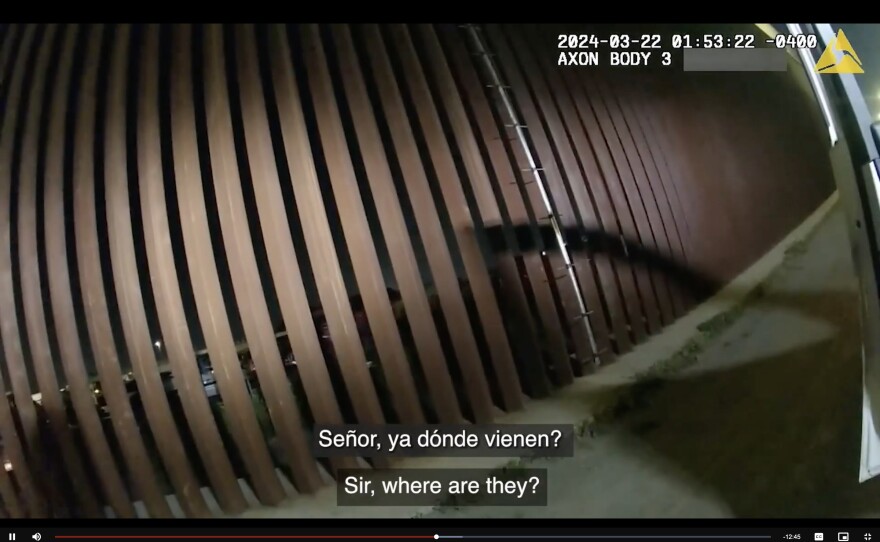
The agent on the south side responds: “You can’t … No, no, I mean–”
Poma Perez’s yells seemed to interrupt them for a moment. Then the agents started arranging transfers for other migrants they apprehended.
CBP did not respond to a list of questions from inewsource including about any policies the agency has in place for responding to emergencies and why the agent could not use the ladder offered by a civilian and another agent.
The agent on the south side tells the other that he’s having trouble communicating with her from where he is. He asked the other agent to tell her to keep holding on.
‘No, no, no!’
By now, Poma Perez had been holding on for 20 minutes. “Sir, where are they?” she asked.
“They are bringing the firefighters, so you must wait,” the agent said.
A minute later, Poma Perez yelled that she’s going to fall.
“No, no, no!” the agent yelled.
A second later, the camera captured the flash of her body, seen between the pillars of the border fence, crashing to the ground.
The agent approached the fence, then walked back to his vehicle and radioed in: “Yeah, we’re gonna need EMS on the north side of the border secondary.”
Minutes later, another agent arrived on the north side, stepped out of his car and approached Poma Perez’s body on the ground.
The camera captured what appears to be blood dripping from the concrete platform at the bottom of the wall. Just below, Poma Perez was still, facing up on the ground. A large pool of blood formed near her head.
The agent did not appear to check Poma Perez’s pulse or render medical aid. He then radioed in that the female had “massive head trauma” and was unresponsive. He asked if emergency medical services were still coming.
“Yeah, she f– fell and hit her head, dude,” the agent said a minute later.
Seconds later, another agent arrived in a vehicle. “Do I even wanna look at this?” he said.
The two agents still didn’t know EMS when they would arrive. A third on the other side of the fence asked again where EMS was.
Soon, the lights of a fire vehicle appeared in the distance down the dirt road.
“They didn’t make it in time. She couldn’t hold on.” one agent said.
Around 11:04 p.m., half-an-hour after Fire-Rescue received the initial call, they arrived. The crew assessed the woman, found that she had no pulse and performed CPR.
Poma Perez was declared dead at 11:17 p.m. She died from blunt force head trauma, according to her death certificate.
“Did you guys see her fall?” one person in the crew asked the agents.
One agent replied that they had been working traffic when it happened. But he pointed his flashlight toward the fence above Poma Perez, where the light caught glints of the makeshift ladder sitting on the other side.
“They got their ladder right there,” the agent said.
CBP’s video can be viewed here. It is extremely graphic and may be disturbing to viewers.


